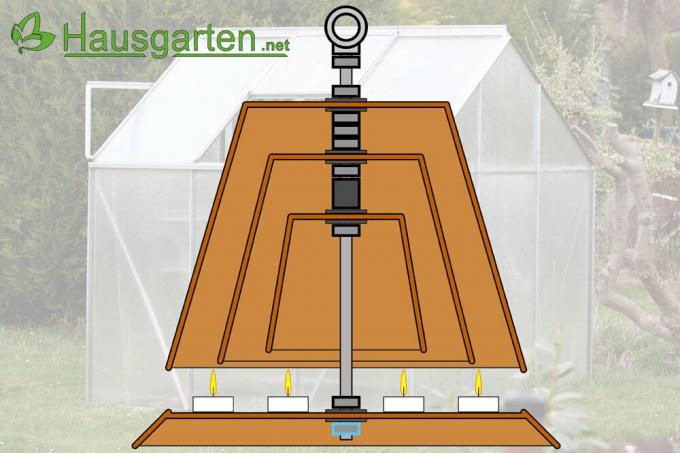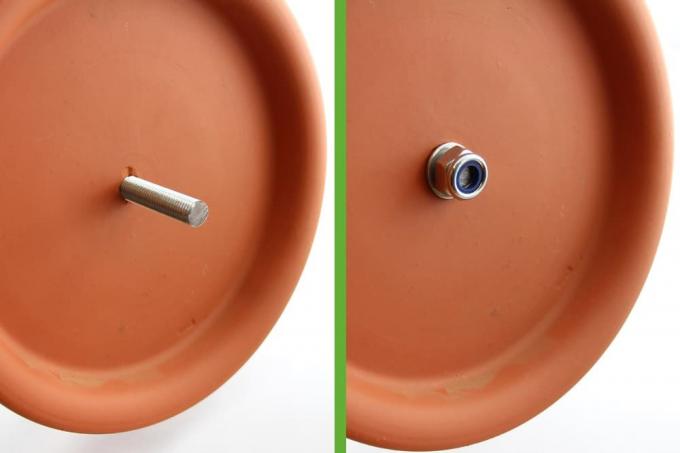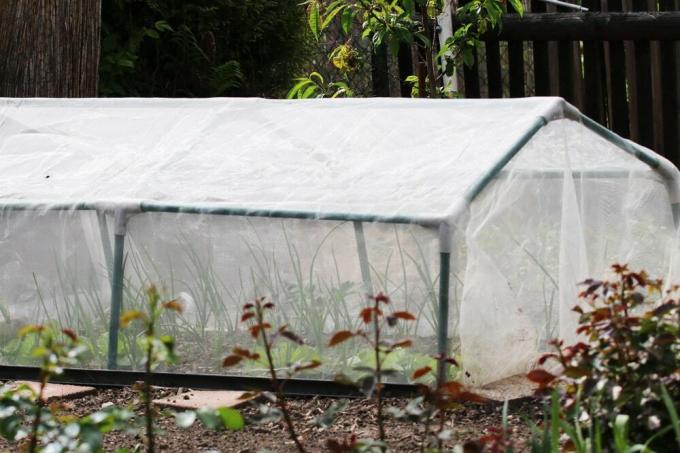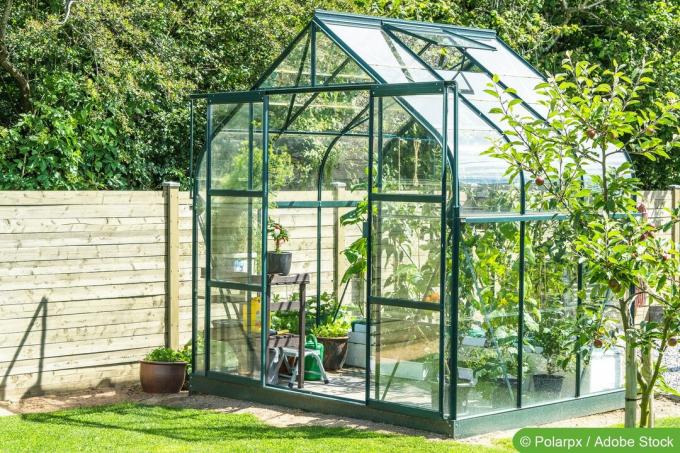

Table of contents
- Greenhouse heating with candles
- you need
- Instructions
- Step 1
- step 2
- step 3
- step 4
- step 5
- step 6
- Safety - Be careful hot!
- hand warmers
- tealight distance
- Safe footing
- Fire danger
There are various ways to protect your greenhouse and the plants for the new season from the dreaded afterfrost at night. In addition to radiant heaters, which eat up electricity or are operated with gas, there is also a relatively simple DIY solution.
Greenhouse heating with candles
The construction is relatively simple, the material costs are manageable, the usability is almost unlimited (in the open air and in the greenhouse) and the running costs can almost be neglected. With a tea light oven you can heat your greenhouse or spend a cozy evening outdoors and use it to warm your hands.
you need
Tool
- ruler
- Pencil
- Duct tape or masking tape
- Cordless drill or drill
- masonry drill
- spanner
- Glove
- safety goggles

material
- Threaded rod (if it is too long, shorten it with a hacksaw)
- nuts
- Threaded spacers (distance bolts, spacer sleeve) (alternatively further nuts)
- Self-locking nuts
- washers
- Clay pots in at least 2 sizes
- A sound coaster
- Tea lights & (stick) lighter
Instructions
In order not to experience a nasty surprise later, you should either make a sketch beforehand or at least measure the pots and nuts so that everything fits in the end.
Step 1
Roughly tape the middle of the coaster from both sides with adhesive tape and then draw in the exact middle. The tape prevents the clay from bursting out when drilling and the exact center prevents the greenhouse heater from tipping and tipping later.
step 2
Find a stable surface, use appropriate protective clothing (gloves and goggles). Carefully drill a hole exactly in the marked center of the coaster. Remember that terracotta is a very brittle material and small chips can occur at the hole. The hole will end up being covered by washers and candles anyway, so don't panic.
Tip:
Drill slowly, with few revolutions, moderate pressure and never use the hammer drill function.

When the hole is drilled through the plate you can carefully remove the tape. Small cracks are not bad.
step 3
Screw a nut approx. a hand's breadth, followed by a washer, onto the threaded rod. Guide the threaded rod through the plate from below, first thread a washer and then a self-locking nut onto the rod and tighten it. Now turn the plates around and counter on the underside of the plate with the washer and nut until the rod is tight.
A notice:
The construction should only look like an umbrella turned upside down by the wind.
step 4

Place the plate “wrong side” so that the threaded rod is pointing up and the plate is on its edge. You have now created the stable basis for the greenhouse heating. Now follows a nut with a washer on the rod, this should have the height of the smallest flower pot space up to the plate + the height of 3 tea lights. Here the first flower pot is turned over.
step 5
The first pot is secured with a washer + spacer sleeve and screwed hand-tight. The height of the spacer sleeve corresponds to the difference in size from the smallest flower pot to the next larger one. Counter the spacer with another nut.
Tip:
As an alternative to spacer sleeves / spacer bolts, you can also overcome the height difference with several normal nuts and thus compensate for the difference with an even more precise fit.
step 6

Before the next planter comes another washer on the threaded rod. Then follows the pot which is again secured with a washer and nut. With this technique you can keep stacking as many pots on top of each other. There should be at least two pots to be able to use the heat storage effect. The more pots are used, the wider and more stable the base plate must be so that the tea light oven does not tip over.
Tip:
The greenhouse heater does not necessarily have to be on the ground. You can also hang the heater up with a ring nut at the top end of the threaded rod. Here you should definitely screw on a nut beforehand to counter the ring nut securely.

Safety - Be careful hot!
"If you play with fire, you can burn your fingers!"
The same applies to the tea light oven.
hand warmers
If you also want to use the greenhouse heater as a hand warmer for a long evening in the garden or when night fishing, you should work with at least two pots. A single pot would be too hot to touch - Risk of burns! A second pot not only has better heat storage, but also serves to ensure safety.
tealight distance
With a candle, the wax does not burn directly, but rather the evaporating gases from the wax. So imagine never (!) too many tea lights at once too close together. Because candles and tea lights are placed too close together, an invisible cloud of gas can form that is highly flammable. Always keep at least "half" a tealight away from the next. Otherwise a paraffin deflagration (wax explosion) can occur, which is really not to be trifled with.
Safe footing
If you notice that nuts keep loosening and loosening, you can always counter them with another nut to get even more security. Always make sure that the greenhouse heater made of candles has a secure footing, does not wobble and cannot fall or fall over.
Fire danger

Even if tea lights are considered relatively (!) safe, you should still not store any combustible materials in the immediate vicinity of the tea light stove. Do not leave the greenhouse heater unattended for the first few runs. Before each use, check the stability of the construction, the safe stand and whether all the pots are still whole.
Tip:
If the pots are cracked, they should be replaced.
 garden editorial
garden editorial I write about everything that interests me in my garden.
Learn more about greenhouse

11 tips for greenhouse planting | What goes in the greenhouse?
A greenhouse is the pride of many amateur gardeners. With a good planting plan, the gardening season can be extended. It is mainly used for growing vegetables. However, it is also suitable for growing other plants or for overwintering potted plants.

Build a mini greenhouse yourself: 4 ideas for a DIY indoor greenhouse
A mini greenhouse can be built quite quickly and is a good alternative to a purchased indoor greenhouse. In addition to small plant experiments with children, you can also very well prefer the vegetables for the garden.

Build a foil tunnel yourself – DIY instructions for a simple plant tunnel
If there is a polytunnel in the garden, you can outsmart bad weather. Well protected from rain, hail and frost, vegetables and salads thrive. You don't have to dig deep into your pocket for this practical garden helper. This DIY guide explains how to build a simple plant tunnel yourself.

Greenhouse Foundation: Setup & Building Tips
For the garden lover, his greenhouse is the ultimate. With the self-construction of your own greenhouse you create the best opportunities for your individual cultures grow and harvest vegetables, flowers or herbs less dependent on the season and the prevailing weather can.

Build your own tomato house – building instructions made of wood and foil
Anyone who is tired of buying tomatoes in the supermarket or using goods from abroad can also help themselves. It's easy and not particularly expensive to grow your own tomato plants in your own garden.

The 17 most common cucumber diseases in the field and greenhouse
Cucumbers can be found in many gardens and greenhouses and are very popular among gardeners. However, there are some cucumber diseases that can severely deplete your harvest, whether grown outdoors or in a greenhouse. Find out what typical cucumber diseases there are, how to recognize them and what countermeasures to take.

